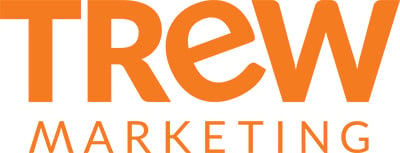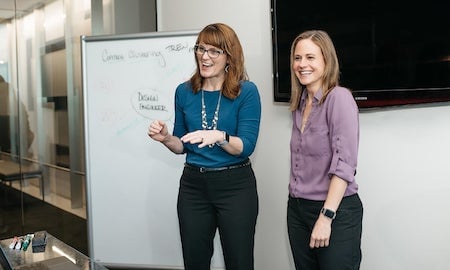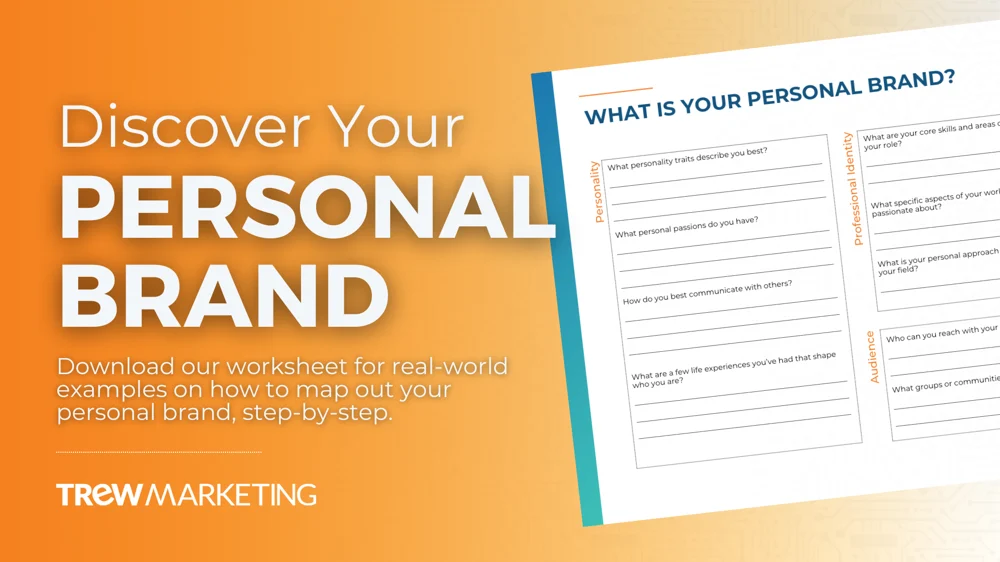The lines between corporate and personal branding are becoming increasingly blurred.
For engineering companies and other technical industries, personal branding offers an unparalleled opportunity to amplify your corporate brand’s message, build thought leadership with your audience, and humanize your business.
While corporate brands project a unified identity, personal brands bring the credibility, relatability, and expertise of individuals to the forefront, fostering connections that drive engagement and growth.

The Difference Between Corporate and Personal Brands
A corporate brand encompasses the overall identity and perception of a company—its tone, values, and promises to its customers. Think of style guides, value propositions, and consistent messaging across platforms. The goal is to deliver a cohesive and professional image that resonates with a broad audience.
A personal brand, on the other hand, represents an individual’s professional identity, shaped by their skills, values, and expertise. Personal brands are inherently flexible and diverse, reflecting the unique voice, personality, and affiliations of the individual. They can include hobbies, communication styles, and areas of expertise that make someone relatable and trustworthy.
Corporate brands thrive on consistency. Personal brands thrive on authenticity.
Together, they create a powerful synergy: corporate brands establish trust at scale, while personal brands provide the human touch customers increasingly crave.
Building Personal Brands at Your Company
Why Invest in Personal Brands?
Companies should care deeply about personal brands because in long B2B sales cycles—often stretching from 12 to 24 months or longer—buyers crave consistent, trusted sources of information. In this context, corporate messaging alone often isn’t enough. Personal brands act as a bridge between technical buyers and the broader organization, offering authenticity, expertise, and ongoing visibility in ways a faceless brand cannot.
According to the State of Marketing to Engineers Report, engineers still want to hear from people, especially when navigating complex topics such as automation systems, CAD software, or sustainability solutions. They turn to technical publications, and applications engineers for trusted information. In a world overflowing with information, individual voices who are known, respected, and relatable cut through the noise and help move prospects along their journey.
Strong personal brands serve as vital extensions of the corporate brand. When employees build public, respected personas—whether as engineers, marketers, executives, or technical specialists—they increase the company’s reach, credibility, and influence. Personal brands and corporate brands are not in opposition; instead, they can and should reinforce one another. A programmer talking about plant-floor software issues or a VP of engineering discussing cloud-based MES platforms all reinforce the company’s expertise, just through a human lens. This layered messaging strategy helps tailor thought leadership to a buyer’s specific needs, role, or stage in the buying process.
Strategically cultivating personal brands also supports specific corporate initiatives—whether it’s aligning with industry trends, supporting a technology partner, or amplifying a niche application area. This approach not only shortens the path to trust but also de-risks future engagement, as buyers begin to see your team not just as vendors but as advisors and collaborators.
Personal branding can transform your organization’s engagement strategy. A well-established personal brand:
- Amplifies corporate messaging by aligning individual voices with the company’s mission.
- Builds bridges with prospects who prefer peer-to-peer interactions over traditional corporate communication.
- Positions employees as trusted resources, technical experts, or admired influencers in their fields.
For example, a startup aiming to engage C-suite executives might struggle with traditional outreach. But an R&D engineer attending an alumni gathering can spark a conversation that leads to a meeting, simply by leveraging their expertise and personal brand.
First, Define Personal Brands for Individuals
Defining your personal brand starts with introspection and honest self-assessment. Look inward to identify your unique skills, values, and attributes. You can also gain invaluable perspectives by seeking feedback from your colleagues, manager, and peers. These external insights often highlight strengths and qualities you might overlook.
- Self-Assessment: Start by asking reflective questions:
- What are my core strengths and skills?
- What specific aspects of my work am I passionate about?
- Who am I trying to reach, and what communities do I identify with?
- Feedback: Gather insights from colleagues, customers, and friends:
- Why did you hire me?
- How do I add value to discussions or projects?
- What do I bring that’s uniquely me?
- Outline Attributes: Define key elements of your brand:
- Professional identity (e.g., problem solver, data analyst, communicator).
- Audience (e.g., potential clients, industry peers, internal teams).
- Personal attributes (e.g., approachable, innovative, technical).
- Align with Corporate Initiatives to Create Content: Use platforms like LinkedIn to share expertise, build thought leadership, and engage with your audience. Tailor your tone and content to align with both your personal voice and corporate goals.
Once you define your own personal brand, it will be easier to lead your SMEs through the personal branding process.
Then, Scale a Network of Personal Brands
Scaling personal branding efforts across an organization requires structure and support.
Here’s how to get started:
- Identify Participants: Work with leadership to identify employees who embody the company’s values and expertise. These individuals should be passionate about their fields and willing to engage externally. Selecting the right participants ensures that the company’s messaging is represented authentically and effectively.
- Train and Align: Host workshops to educate employees about the company’s overarching goals, key messages, and branding initiatives. These sessions can include practical exercises on crafting content, speaking authentically, and aligning personal branding efforts with corporate strategies. This step helps ensure consistency across all personal brand activities.
- Provide Resources: Equip employees with tools and templates to make personal branding easier. For example, create content libraries, pre-approved messaging briefs, and sample LinkedIn posts tailored to specific industries. Providing these resources empowers participants to maintain quality and consistency in their efforts.
- Encourage Collaboration: Facilitate regular meetings between marketing, sales, and individual contributors to share insights, discuss successes, and address challenges. Cross-department collaboration fosters innovation and ensures alignment between personal and corporate branding strategies.
- Measure and Iterate: Establish metrics to evaluate the success of personal branding efforts, such as LinkedIn engagement rates, follower growth, and qualitative feedback from peers or clients. Use these insights to refine strategies, identify best practices, and continuously improve the program.
Examples of Using Personal Brands Within an Organization
Let’s take the example of a manufacturing company that is focusing on software and services with a new initiative around an MES platform. The corporate message they’ve landed on is as follows:
We bring digital transformation to large, growing manufacturers through Manufacturing Execution Systems that provide accurate, actionable data.
Here’s what personal branding execution could look in a cross-functional team promoting the company through their personal brands:
Employee: Maria, CEO
- Personal Brand Attributes: Visionary leader, marathoner, financially savvy, well respected in technology, moved into manufacturing from software
- Audience: CEOs, CFOs, Large event organizers,
- Focus: “Digital transformation at the enterprise level will impact plant automation, production scalability, and security over the next 10 years. What you invest in this year will drastically affect your bottom line.”
- Messages (Platforms):
- The marathon of digital transformation – the end-to-end plan for manufacturers (bi-weekly podcast, 26 episodes)
- True costs of digital transformation and opportunity costs of missing out (keynote speech)
- Companies leading the way in digital transformation – single line ROI metrics (Linkedin, monthly)
Employee: Brian, Programmer
- Personal Brand Attributes: Self-taught coder at a young age, award for answering the most support calls an hour as an applications engineer, beer enthusiast, happy to help fix a problem when he can – has a youtube following with technical tips and tricks for mechanical and electrical engineers
- Audience: plant floor operators, machinists, techs, plant floor supervisors,
- Focus: “Here are the top 5 software issues we see on the plant floor…and they’re all easily preventable with our MES solution.”
- Messages (Platforms):
- 5 preventable issues causing your plant millions in downtime each year (contributed article for a trade publication)
- Ways you didn’t know your MES could work smarter for you (youtube series)
- How plant floor operators can escalate technology problems and let decision makers know about critical systems issues on the plant floor (Manufacturing Happy Hour podcast guest)
These two people are incredibly different in their careers and expertise, but they can each reach different audiences with an authentic message.
Putting Personal Branding Into Practice
To help individuals and teams of individuals build out a network of personal brands within their organizations, we have a downloadable worksheet. On the first side of the worksheet, an individual can answer questions about themselves, their personalities, professional identity, and audience, and then on the back side, begin to tie those personal aspects to potential content topics that relate to a corporate initiative like we did above with Maria and Brian.
This exercise is best done in pairs, where one individual interviews the other, helping their partner best identify their personality strengths and potential content topics. It’s often easiest for us to quickly see the potential in others.
Legalities of Personal Brands
As personal branding grows, so does the need for clarity around its boundaries. Companies should be proactive in:
Companies must navigate the legalities of personal branding with care and precision. Drafting clear policies is essential to define what employees can and cannot share about their work, ensuring that sensitive information remains protected. Typically, and especially for technical companies, LinkedIn is a place for personal brands to talk about professional topics. Anywhere a person is affiliating themselves with the company (like on LinkedIn, meant for connecting professional relationships), companies expect employees to represent the company as if they were at a company-related function.
Respecting intellectual property laws is equally critical, as employees need to understand the boundaries of proprietary information, particularly when creating content. This is even more critical for public companies. Providing regular training on social media best practices, confidentiality, and appropriate representation helps employees align their personal branding efforts with company standards.
Lastly, encouraging transparency fosters an open dialogue about expectations and responsibilities, reducing the risk of misunderstandings while supporting personal branding initiatives. As content is no longer hidden with the internet and sharing of information, individuals should be aware of what they share and how it represents both themselves and their organization.
Conclusion
Ultimately, when companies empower individuals to speak with clarity, confidence, and relevance, they scale brand impact exponentially. Personal brands humanize the buying experience, especially in complex technical industries. They build lasting relationships that outlive marketing campaigns—and that’s something no logo or tagline can do alone.
Ready to get started building your personal brand? Check out our Personal Branding Worksheet here.
Need help building a campaign like this? TREW Marketing specializes in brand marketing and for technical B2B companies. Let’s talk.
TREW Marketing partners with engineering and B2B technology companies to elevate their brand, engage their audiences, and generate new opportunities through insightful research and unrivaled industry expertise. Contact us today to learn more about the services we offer.
SUBSCRIBE TO OUR BLOG FOR THE LATEST UPDATES
Morgan Norris
 Morgan believes that the process of brand positioning and messaging powers companies by aligning corporate leadership, building a story that fuels staff and engages customers, and creating a foundation for consistent content – and she’s seen these results come true for TREW clients time and again over the last decade. She holds degrees in Public Relations and Spanish, with a minor in Business from The University of Texas at Austin. Morgan, her husband, and three kids recently moved from Austin to downtown DC, where they enjoy walking the city, visiting the local museums, and playing a guess-who-is-in-that-motorcade game.
Morgan believes that the process of brand positioning and messaging powers companies by aligning corporate leadership, building a story that fuels staff and engages customers, and creating a foundation for consistent content – and she’s seen these results come true for TREW clients time and again over the last decade. She holds degrees in Public Relations and Spanish, with a minor in Business from The University of Texas at Austin. Morgan, her husband, and three kids recently moved from Austin to downtown DC, where they enjoy walking the city, visiting the local museums, and playing a guess-who-is-in-that-motorcade game.
About TREW Marketing
TREW Marketing is a strategy-first content marketing agency serving B2B companies that target highly technical buyers. With deep experience in the design, embedded, measurement and automation, and software industries, TREW Marketing provides branding, marketing strategy, content development, and digital marketing services to help customers efficiently and effectively achieve business goals.




 Morgan Norris
Morgan Norris
